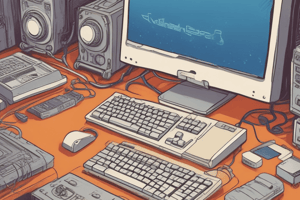Podcast
Questions and Answers
What is the primary feature of Integrated Circuits (ICs) in the third generation of computers?
What is the primary feature of Integrated Circuits (ICs) in the third generation of computers?
- Consumed more power
- Used magnetic core as primary storage
- Generated less heat (correct)
- Used assembly language
What was the primary storage medium in the third generation of computers?
What was the primary storage medium in the third generation of computers?
- Winchester disc
- Optical disc
- Floppy disc
- Magnetic core (correct)
What is a characteristic of the fourth generation of computers?
What is a characteristic of the fourth generation of computers?
- Used assembly language
- Used vacuum tubes
- Consumed more power
- Used Large Scale Integrated (LSI) circuits (correct)
What programming languages were used in the third generation of computers?
What programming languages were used in the third generation of computers?
What is a feature of the fifth generation of computers?
What is a feature of the fifth generation of computers?
What was the primary storage medium in the fourth generation of computers?
What was the primary storage medium in the fourth generation of computers?
What is a characteristic of the third generation of computers?
What is a characteristic of the third generation of computers?
What was the main advantage of the fourth generation of computers?
What was the main advantage of the fourth generation of computers?
What is an application of the fifth generation of computers?
What is an application of the fifth generation of computers?
What was the main feature of the Integrated Circuits (ICs) used in the third generation of computers?
What was the main feature of the Integrated Circuits (ICs) used in the third generation of computers?
Flashcards are hidden until you start studying
Study Notes
Smart Card Reader
- A device used to access the microprocessor of a smart card
- Two types of smart cards: Memory cards (non-volatile memory storage components and specific security logic) and Microprocessor cards (volatile memory and microprocessor components)
Optical Mark Reader (OMR)
- Interpret marks into a data record and send it to the computer for storage, analysis, and reporting
- Widely used in reading answers of objective type tests, voting applications, and evaluation studies
- Uses a beam of light to detect marks on a paper and capture presence and absence of data
Optical Character Recognition (OCR)
- Technique for scanning a printed page, translating it, and using OCR software to recognize the image as ASCII text
- Widely used in acquiring textual data from images in applications like telephone bills, electricity bills, and insurance premium
Biometric Sensor
- Device that recognizes physical traits of an individual
- Used for marking attendance of employees/students in organizations/institutions
Joystick
- Device that moves in all directions and controls the movement of the cursor
- Used in flight simulators, Computer Aided Design/Computer Aided Manufacturing (CAD/CAM) system, etc
- Similar to a mouse, but the movement of the cursor on screen stops as soon as the user stops
Barcode Reader
- Machine-readable representation of information in the form of stripes of dark and light ink
- Used in applications like supermarkets to read the price of a product with a barcode
Computer Hardware
- Fifth generation: Super Large Scale Integrated (SLSI) chips, optical discs, and parallel processing
- Features: artificial intelligence, knowledge processing, and microprocessor implementation enable mega chips
Studying That Suits You
Use AI to generate personalized quizzes and flashcards to suit your learning preferences.




